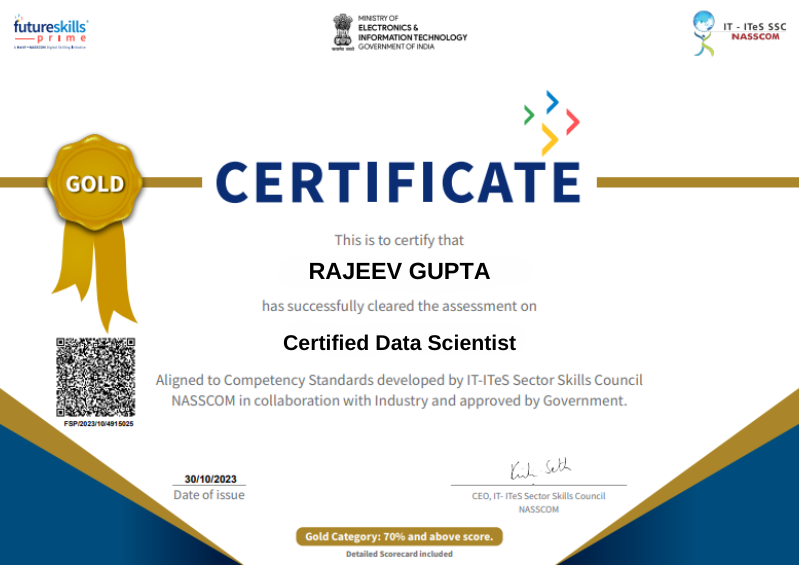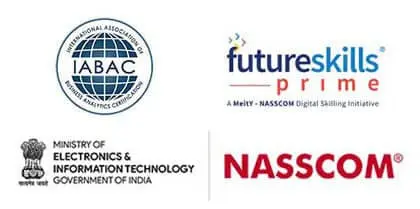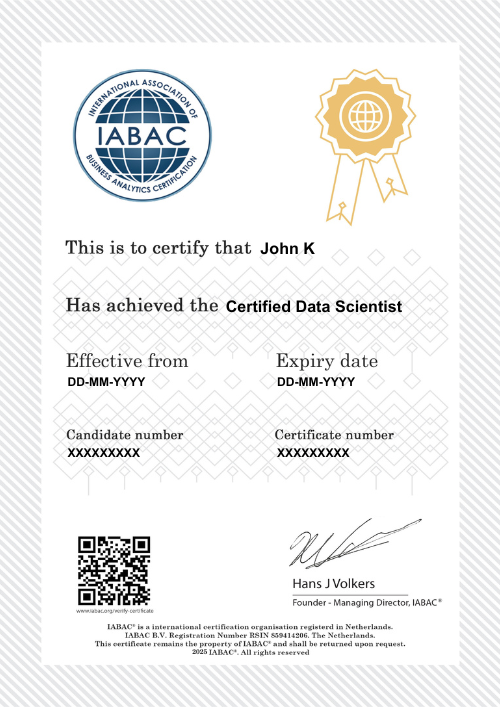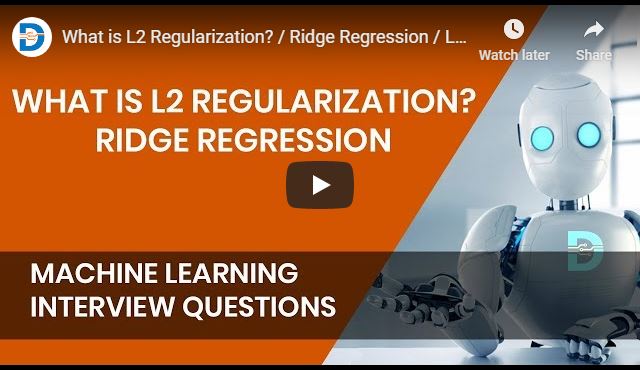Instructor Led Live Online
Self Learning + Live Mentoring
In - Person Classroom Training




MODULE 1: DATA SCIENCE ESSENTIALS
• Introduction to Data Science
• Evolution of Data Science
• Big Data Vs Data Science
• Data Science Terminologies
• Data Science vs AI/Machine Learning
• Data Science vs Analytics
MODULE 2: DATA SCIENCE DEMO
• Business Requirement: Use Case
• Data Preparation
• Machine learning Model building
• Prediction with ML model
• Delivering Business Value.
MODULE 3: ANALYTICS CLASSIFICATION
• Types of Analytics
• Descriptive Analytics
• Diagnostic Analytics
• Predictive Analytics
• Prescriptive Analytics
• EDA and insight gathering demo in Tableau
MODULE 4: DATA SCIENCE AND RELATED FIELDS
• Introduction to AI
• Introduction to Computer Vision
• Introduction to Natural Language Processing
• Introduction to Reinforcement Learning
• Introduction to GAN
• Introduction to Generative Passive Models
MODULE 5: DATA SCIENCE ROLES & WORKFLOW
• Data Science Project workflow
• Roles: Data Engineer, Data Scientist, ML Engineer and MLOps Engineer
• Data Science Project stages.
MODULE 6: MACHINE LEARNING INTRODUCTION
• What Is ML? ML Vs AI
• ML Workflow, Popular ML Algorithms
• Clustering, Classification And Regression
• Supervised Vs Unsupervised
MODULE 7: DATA SCIENCE INDUSTRY APPLICATIONS
• Data Science in Finance and Banking
• Data Science in Retail
• Data Science in Health Care
• Data Science in Logistics and Supply Chain
• Data Science in Technology Industry
• Data Science in Manufacturing
• Data Science in Agriculture
MODULE 1: PYTHON BASICS
• Introduction of python
• Installation of Python and IDE
• Python Variables
• Python basic data types
• Number & Booleans, strings
• Arithmetic Operators
• Comparison Operators
• Assignment Operators
MODULE 2: PYTHON CONTROL STATEMENTS
• IF Conditional statement
• IF-ELSE
• NESTED IF
• Python Loops basics
• WHILE Statement
• FOR statements
• BREAK and CONTINUE statements
MODULE 3: PYTHON DATA STRUCTURES
• Basic data structure in python
• Basics of List
• List: Object, methods
• Tuple: Object, methods
• Sets: Object, methods
• Dictionary: Object, methods
MODULE 4: PYTHON FUNCTIONS
• Functions basics
• Function Parameter passing
• Lambda functions
• Map, reduce, filter functions
MODULE 1: OVERVIEW OF STATISTICS
• Introduction to Statistics
• Descriptive And Inferential Statistics
• Basic Terms Of Statistics
• Types Of Data
MODULE 2: HARNESSING DATA
• Random Sampling
• Sampling With Replacement And Without Replacement
• Cochran's Minimum Sample Size
• Types of Sampling
• Simple Random Sampling
• Stratified Random Sampling
• Cluster Random Sampling
• Systematic Random Sampling
• Multi stage Sampling
• Sampling Error
• Methods Of Collecting Data
MODULE 3: EXPLORATORY DATA ANALYSIS
• Exploratory Data Analysis Introduction
• Measures Of Central Tendencies: Mean,Median And Mode
• Measures Of Central Tendencies: Range, Variance And Standard Deviation
• Data Distribution Plot: Histogram
• Normal Distribution & Properties
• Z Value / Standard Value
• Empirical Rule and Outliers
• Central Limit Theorem
• Normality Testing
• Skewness & Kurtosis
• Measures Of Distance: Euclidean, Manhattan And Minkowski Distance
• Covariance & Correlation
MODULE 4: HYPOTHESIS TESTING
• Hypothesis Testing Introduction
• P- Value, Critical Region
• Types of Hypothesis Testing
• Hypothesis Testing Errors : Type I And Type II
• Two Sample Independent T-test
• Two Sample Relation T-test
• One Way Anova Test
• Application of Hypothesis testing
MODULE 1: MACHINE LEARNING INTRODUCTION
• What Is ML? ML Vs AI
• Clustering, Classification And Regression
• Supervised Vs Unsupervised
MODULE 2: PYTHON NUMPY PACKAGE
• Introduction to Numpy Package
• Array as Data Structure
• Core Numpy functions
• Matrix Operations, Broadcasting in Arrays
MODULE 3: PYTHON PANDAS PACKAGE
• Introduction to Pandas package
• Series in Pandas
• Data Frame in Pandas
• File Reading in Pandas
• Data munging with Pandas
MODULE 4: VISUALIZATION WITH PYTHON - Matplotlib
• Visualization Packages (Matplotlib)
• Components Of A Plot, Sub-Plots
• Basic Plots: Line, Bar, Pie, Scatter
MODULE 5: PYTHON VISUALIZATION PACKAGE - SEABORN
• Seaborn: Basic Plot
• Advanced Python Data Visualizations
MODULE 6: ML ALGO: LINEAR REGRESSSION
• Introduction to Linear Regression
• How it works: Regression and Best Fit Line
• Modeling and Evaluation in Python
MODULE 7: ML ALGO: LOGISTIC REGRESSION
• Introduction to Logistic Regression
• How it works: Classification & Sigmoid Curve
• Modeling and Evaluation in Python
MODULE 8: ML ALGO: K MEANS CLUSTERING
• Understanding Clustering (Unsupervised)
• K Means Algorithm
• How it works : K Means theory
• Modeling in Python
MODULE 9: ML ALGO: KNN
• Introduction to KNN
• How It Works: Nearest Neighbor Concept
• Modeling and Evaluation in Python
MODULE 1: FEATURE ENGINEERING
• Introduction to Feature Engineering
• Feature Engineering Techniques: Encoding, Scaling, Data Transformation
• Handling Missing values, handling outliers
• Creation of Pipeline
• Use case for feature engineering
MODULE 2: ML ALGO: SUPPORT VECTOR MACHINE (SVM)
• Introduction to SVM
• How It Works: SVM Concept, Kernel Trick
• Modeling and Evaluation of SVM in Python
MODULE 3: PRINCIPAL COMPONENT ANALYSIS (PCA)
• Building Blocks Of PCA
• How it works: Finding Principal Components
• Modeling PCA in Python
MODULE 4: ML ALGO: DECISION TREE
• Introduction to Decision Tree & Random Forest
• How it works
• Modeling and Evaluation in Python
MODULE 5: ENSEMBLE TECHNIQUES - BAGGING
• Introduction to Ensemble technique
• Bagging and How it works
• Modeling and Evaluation in Python
MODULE 6: ML ALGO: NAÏVE BAYES
• Introduction to Naive Bayes
• How it works: Bayes' Theorem
• Naive Bayes For Text Classification
• Modeling and Evaluation in Python
MODULE 7: GRADIENT BOOSTING, XGBOOST
• Introduction to Boosting and XGBoost
• How it works?
• Modeling and Evaluation of in Python
MODULE 1: TIME SERIES FORECASTING - ARIMA
• What is Time Series?
• Trend, Seasonality, cyclical and random
• Stationarity of Time Series
• Autoregressive Model (AR)
• Moving Average Model (MA)
• ARIMA Model
• Autocorrelation and AIC
• Time Series Analysis in Python
MODULE 2: SENTIMENT ANALYSIS
• Introduction to Sentiment Analysis
• NLTK Package
• Case study: Sentiment Analysis on Movie Reviews
MODULE 3: REGULAR EXPRESSIONS WITH PYTHON
• Regex Introduction
• Regex codes
• Text extraction with Python Regex
MODULE 4: ML MODEL DEPLOYMENT WITH FLASK
• Introduction to Flask
• URL and App routing
• Flask application – ML Model deployment
MODULE 5: ADVANCED DATA ANALYSIS WITH MS EXCEL
• MS Excel core Functions
• Advanced Functions (VLOOKUP, INDIRECT..)
• Linear Regression with EXCEL
• Data Table
• Goal Seek Analysis
• Pivot Table
• Solving Data Equation with EXCEL
MODULE 6: AWS CLOUD FOR DATA SCIENCE
• Introduction of cloud
• Difference between GCC, Azure, AWS
• AWS Service ( EC2 instance)
MODULE 7: AZURE FOR DATA SCIENCE
• Introduction to AZURE ML studio
• Data Pipeline
• ML modeling with Azure
MODULE 8: INTRODUCTION TO DEEP LEARNING
• Introduction to Artificial Neural Network, Architecture
• Artificial Neural Network in Python
• Introduction to Convolutional Neural Network, Architecture
• Convolutional Neural Network in Python
MODULE 1: DATABASE INTRODUCTION
• DATABASE Overview
• Key concepts of database management
• Relational Database Management System
• CRUD operations
MODULE 2: SQL BASICS
• Introduction to Databases
• Introduction to SQL
• SQL Commands
• MY SQL workbench installation
MODULE 3: DATA TYPES AND CONSTRAINTS
• Numeric, Character, date time data type
• Primary key, Foreign key, Not null
• Unique, Check, default, Auto increment
MODULE 4: DATABASES AND TABLES (MySQL)
• Create database
• Delete database
• Show and use databases
• Create table, Rename table
• Delete table, Delete table records
• Create new table from existing data types
• Insert into, Update records
• Alter table
MODULE 5: SQL JOINS
• Inner Join, Outer Join
• Left Join, Right Join
• Self Join, Cross join
• Windows function: Over, Partition, Rank
MODULE 6: SQL COMMANDS AND CLAUSES
• Select, Select distinct
• Aliases, Where clause
• Relational operators, Logical
• Between, Order by, In
• Like, Limit, null/not null, group by
• Having, Sub queries
MODULE 7 : DOCUMENT DB/NO-SQL DB
• Introduction of Document DB
• Document DB vs SQL DB
• Popular Document DBs
• MongoDB basics
• Data format and Key methods
MODULE 1: GIT INTRODUCTION
• Purpose of Version Control
• Popular Version control tools
• Git Distribution Version Control
• Terminologies
• Git Workflow
• Git Architecture
MODULE 2: GIT REPOSITORY and GitHub
• Git Repo Introduction
• Create New Repo with Init command
• Git Essentials: Copy & User Setup
• Mastering Git and GitHub
MODULE 3: COMMITS, PULL, FETCH AND PUSH
• Code Commits
• Pull, Fetch and Conflicts resolution
• Pushing to Remote Repo
MODULE 4: TAGGING, BRANCHING AND MERGING
• Organize code with branches
• Checkout branch
• Merge branches
• Editing Commits
• Commit command Amend flag
• Git reset and revert
MODULE 5: GIT WITH GITHUB AND BITBUCKET
• Creating GitHub Account
• Local and Remote Repo
• Collaborating with other developers
MODULE 1: BIG DATA INTRODUCTION
• Big Data Overview
• Five Vs of Big Data
• What is Big Data and Hadoop
• Introduction to Hadoop
• Components of Hadoop Ecosystem
• Big Data Analytics Introduction
MODULE 2 : HDFS AND MAP REDUCE
• HDFS – Big Data Storage
• Distributed Processing with Map Reduce
• Mapping and reducing stages concepts
• Key Terms: Output Format, Partitioners,
• Combiners, Shuffle, and Sort
MODULE 3: PYSPARK FOUNDATION
• PySpark Introduction
• Spark Configuration
• Resilient distributed datasets (RDD)
• Working with RDDs in PySpark
• Aggregating Data with Pair RDDs
MODULE 4: SPARK SQL and HADOOP HIVE
• Introducing Spark SQL
• Spark SQL vs Hadoop Hive
MODULE 1: TABLEAU FUNDAMENTALS
• Introduction to Business Intelligence & Introduction to Tableau
• Interface Tour, Data visualization: Pie chart, Column chart, Bar chart.
• Bar chart, Tree Map, Line Chart
• Area chart, Combination Charts, Map
• Dashboards creation, Quick Filters
• Create Table Calculations
• Create Calculated Fields
• Create Custom Hierarchies
MODULE 2: POWER-BI BASICS
• Power BI Introduction
• Basics Visualizations
• Dashboard Creation
• Basic Data Cleaning
• Basic DAX FUNCTION
MODULE 3 : DATA TRANSFORMATION TECHNIQUES
• Exploring Query Editor
• Data Cleansing and Manipulation:
• Creating Our Initial Project File
• Connecting to Our Data Source
• Editing Rows
• Changing Data Types
• Replacing Values
MODULE 4: CONNECTING TO VARIOUS DATA SOURCES
• Connecting to a CSV File
• Connecting to a Webpage
• Extracting Characters
• Splitting and Merging Columns
• Creating Conditional Columns
• Creating Columns from Examples
• Create Data Model
Data Science courses in Madhapur typically range from 3 months to 1 year, depending on the program’s depth. Short-term courses emphasize practical skills, while longer programs integrate theoretical knowledge with industry-relevant applications, with duration varying across full-time, part-time, or online modes.
Many institutes offer Data Science courses in Madhapur, but DataMites Institute stands out as a preferred choice. It provides extensive training, internationally recognized certifications, and hands-on projects to strengthen practical skills. With skilled instructors and focused career support, DataMites builds a solid foundation in Data Science, preparing learners for successful career advancement.
Anyone with a basic understanding of mathematics and statistics can enroll. The program is suitable for both recent graduates and working professionals. Although prior programming experience can be beneficial, it is not always mandatory.
The Data Science course fees in Madhapur typically range from Rs 15,000 to Rs 2,50,000, depending on the institute, course duration, and mode of training. Learners can select from online, classroom, or self-paced options according to their requirements.
According to AmbitionBox, a Data Scientist in Hyderabad earns between INR 4 Lakhs and INR 25 Lakhs per year, with an average annual salary of INR 15 Lakhs. This salary range reflects variations based on experience, skills, and the hiring organization.
To excel in Data Science Training in Madhapur, a robust foundation in mathematics and statistics is vital. Proficiency in programming languages like Python and R, familiarity with data visualization and analysis tools like Tableau and Power BI, and possessing critical thinking, problem-solving, and communication skills are highly valued. These skills form the basis for effective data analysis and interpretation.
Learning Data Science may pose challenges such as understanding complex mathematical concepts, coding in languages like Python or R, handling large datasets, and staying updated with evolving technology. Overcoming these hurdles requires a structured learning approach, consistent practice, and perseverance to master the multifaceted aspects of Data Science.
Data science careers in Hyderabad are in high demand across various sectors. Businesses are increasingly relying on data-driven insights to make strategic decisions. In the coming years, job opportunities in this field are expected to rise significantly, especially in AI, machine learning, and analytics within the city.
Yes, Python is essential for most Data Science courses because it is easy to learn and offers powerful libraries such as Pandas, NumPy, and Scikit-learn. It serves as the main language for data analysis, machine learning, and data visualization.
Yes, statistics is crucial for learning Data Science. It enables understanding of data patterns, hypothesis testing, and the creation of accurate models that provide reliable insights and predictions.
Basic coding knowledge is important since Data Science involves programming for data analysis, visualization, and machine learning. Beginners can learn coding during the course, but having prior proficiency improves efficiency and career preparedness.
A data science course trains learners to create models, develop predictive algorithms, and extract insights from complex datasets. While data analysts focus on interpreting data to identify patterns, data scientists take it further by designing solutions that drive business strategies. In essence, analysts provide insights, whereas data scientists turn those insights into actionable innovations.
To become a Data Scientist in Hyderabad, start by building a strong foundation in mathematics, statistics, and programming languages like Python or R. Gain hands-on experience through projects, internships, or certified courses. Finally, enhance your skills in machine learning, data analysis, and visualization to secure a role in the field.
Starting a career in Data Science in Madhapur involves building strong skills in Python, statistics, machine learning, and data visualization, along with practical, hands-on project experience. Enrolling in a well-structured Data Science course that provides internship or placement support ensures valuable industry exposure and effective career guidance.
Data Science courses cover Python, R, SQL, Excel, Tableau, Power BI, Hadoop, Spark, and Scikit-learn. Learners also gain practical experience with tools like Jupyter Notebook, Google Colab, and cloud platforms such as AWS or Azure.
A Certified Data Scientist program offers structured training in data analysis, machine learning, and statistical modeling. It validates the ability to handle complex data tasks and apply analytical methods to real-world problems, boosting career opportunities in the data science field.
Industries that benefit most from Data Science include finance, healthcare, e-commerce, retail, telecommunications, and manufacturing. These sectors leverage data-driven insights for decision-making, customer behavior analysis, fraud detection, predictive maintenance, and improving operational efficiency.
Yes, freshers can join a data science course in Madhapur and develop the necessary skills. Many institutes provide job assistance, improving the chances of landing a role. Success depends on consistent learning, hands-on projects, and keeping up with industry trends.
Hyderabad has numerous job openings for data science freshers in roles such as data analyst, machine learning engineer, and junior data scientist. Many companies look for candidates with strong analytical skills and proficiency in Python and SQL. Regularly checking job portals and company websites helps in discovering suitable opportunities.
Yes, non-IT graduates can pursue a career in data science. By enhancing their knowledge in mathematics, statistics, and analytical thinking, and completing a data science course, they can acquire essential programming and machine learning skills. Many data scientists have successfully transitioned from varied academic backgrounds outside IT.
Anyone with a basic understanding of mathematics and statistics can enroll in DataMites Data Science courses. These programs are ideal for fresh graduates, working professionals, and career changers. Even students without prior programming experience receive foundational training to help them understand key concepts.
The DataMites data science course in Madhapur spans from 1 to 8 months, catering to diverse learning needs and schedules. Weekday and weekend training sessions are available, providing flexibility to accommodate the preferences of students.
Yes, DataMites Madhapur offers a Data Science course with placement assistance. The program includes hands-on training, live projects, and career support to help learners secure data-focused roles.
DataMites offers Data Science courses in Madhapur with a comprehensive curriculum, experienced instructors, and robust placement support. The programs emphasize industry-relevant tools and skills, preparing students for successful careers in data science, while providing clear guidance and professional mentorship throughout the learning journey.
Yes, DataMites Madhapur offers Data Science courses that include internships. The programs feature live projects and internship certificates, providing students with valuable hands-on experience, and are available in both classroom and online formats.
Yes, live projects are a key component of the DataMites course. Students engage with real-world problems, acquiring practical experience that connects theoretical learning with industry needs.
DataMites offers a wide range of Data Science courses, including Data Science Foundation, Data Science for Managers, Data Science Associate, Diploma in Data Science, Python for Data Science, Certified Data Scientist, Statistics for Data Science, and industry-specific programs. This variety enables individuals to select a course that aligns with their career objectives.
The DataMites Data Science course fee in Madhapur varies depending on the chosen learning mode. The live virtual program is priced at INR 60,000, the blended learning option costs INR 35,000, and classroom training is available for INR 65,000. For the latest and most accurate fee details, it is recommended to contact the Madhapur center directly.
Students at DataMites receive access to study materials for 6 months to 1 year, enabling them to revisit content and practice concepts throughout the course. This supports continuous learning and reinforces essential skills.
After completing a course at DataMites, learners receive certifications from recognized organizations like IABAC® and NASSCOM® FutureSkills. These certificates validate skills in Data Science, Artificial Intelligence, and Machine Learning, boosting career opportunities in the field.
DataMites provides multiple payment options for course enrollment, including debit/credit cards (Visa, MasterCard, American Express) and PayPal. Once the payment is completed, you receive confirmation along with the required course materials. Assistance is also available to guide you through the payment process if needed.
DataMites provides a free demo class for those interested in exploring data science, allowing prospective learners to experience the course content and teaching style before enrolling. The full program spans 8 months, offering 700 hours of comprehensive learning.
Yes, offline data science courses are available at the Madhapur branch, which provides in-person training in data science and machine learning. The center is located at 313, 4th Floor, Ayyappa Society Main Rd, Ayyappa Society, Megha Hills, Madhapur, Hyderabad, Telangana 500081. It is conveniently accessible from nearby areas in Hyderabad, including Hitech City (500081), Gachibowli (500032), Kondapur (500084), Jubilee Hills (500033), Madhapur (500081), and Kavuri Hills (500081), making it easy for local residents and professionals to attend the offline courses. For enrollment, course schedules, fees, or curriculum details, it is recommended to contact the center directly.
DataMites Madhapur offers a full refund if cancellation is requested within one week of the course start, provided at least two sessions have been attended. Refunds are typically processed within 5–7 business days and are not applicable after six months from enrollment.
Yes, DataMites allows students to switch between offline and online modes if required, offering flexibility to continue learning without any disruption.
The DataMites Placement Assistance Team(PAT) facilitates the aspirants in taking all the necessary steps in starting their career in Data Science. Some of the services provided by PAT are: -
The DataMites Placement Assistance Team(PAT) conducts sessions on career mentoring for the aspirants with a view of helping them realize the purpose they have to serve when they step into the corporate world. The students are guided by industry experts about the various possibilities in the Data Science career, this will help the aspirants to draw a clear picture of the career options available. Also, they will be made knowledgeable about the various obstacles they are likely to face as a fresher in the field, and how they can tackle.
No, PAT does not promise a job, but it helps the aspirants to build the required potential needed in landing a career. The aspirants can capitalize on the acquired skills, in the long run, to a successful career in Data Science.










